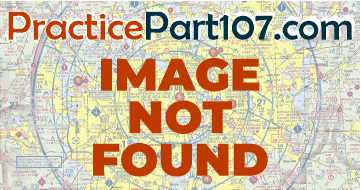FAA(Refer to FAA-CT-8080-2H, Figure 21.) What airport is located approximately 47° 40′ N latitude and 101° 26′ W longitude?
- ✅A:Mercer County Regional Airport.
- ❌B:Semshenko Airport.
- ❌C:Garrison Airport.

FAA-CT-8080-2H Figure 21 Area None - Click to enlarge.
Answer Figure

Click to enlarge answer figure
Explanations
- A: Correct. The coordinates 47° 40′ N latitude and 101° 26′ W longitude match Mercer County Regional Airport. Understanding how to read and interpret latitude and longitude on sectional charts is crucial for safe and efficient drone operations, particularly when planning flights near airports. Incorrect interpretation could lead to safety risks and regulatory violations.
- B: Incorrect. Semshenko Airport is not located at the coordinates 47° 40′ N latitude and 101° 26′ W longitude. Misinterpreting coordinates can lead to operational errors, potential safety risks, and regulatory violations.
- C: Incorrect. Garrison Airport is not located at the coordinates 47° 40′ N latitude and 101° 26′ W longitude. Misinterpreting coordinates can lead to operational errors, potential safety risks, and regulatory violations.
🧭 Instructor Note
Why This Matters for Your Business
The ability to accurately read and interpret latitude and longitude coordinates on sectional charts is crucial for commercial drone operations. This skill is particularly important when planning flights near airports, where accurate positioning is essential to maintain safe distances and comply with FAA regulations. Misinterpretation of coordinates could lead to operational errors, potential safety risks, and regulatory violations, all of which could negatively impact your business reputation and profitability.
Safety & Liability Considerations
Misinterpreting coordinates can lead to drones operating in restricted or unsafe areas, increasing the risk of collisions, damage, and injury. Additionally, operating in restricted airspace without proper authorization can result in regulatory violations, fines, and legal issues. Ensuring accurate interpretation of coordinates is a key step in mitigating these risks.
Consider This Scenario
A commercial drone operator is contracted to conduct a detailed survey of a construction site located near Mercer County Regional Airport. The operator must accurately interpret the site's coordinates on the sectional chart to plan the flight path, maintain a safe distance from the airport, and ensure compliance with FAA regulations. Misinterpreting the coordinates could lead to the drone entering the airport's airspace, posing safety risks and potential regulatory violations.
What the FAA is Testing
The FAA is testing the ability to read and interpret latitude and longitude coordinates on a sectional chart, a fundamental skill for safe and efficient drone operations. This includes identifying the location of specific airports based on their coordinates.
Business Success Strategy
Develop a thorough understanding of how to read and interpret coordinates on sectional charts. Use tools like interactive coordinate locators and practice quizzes to reinforce this skill. Always double-check coordinates when planning flights, particularly near airports, to ensure safety and compliance.
Memory Aid
"Flat-itude" and "Long-itude". Latitude is the flat lines circling the earth. Longitude is the long lines from south pole to north pole.
Enhanced References
FAA Aeronautical Chart User's Guide, Section 4: Latitude and Longitude.
Related Concepts
- Reading sectional chart coordinates
- Latitude and longitude basics
- Airport location identification
ACS Code: UA.V.B.K6a
Difficulty: intermediate
